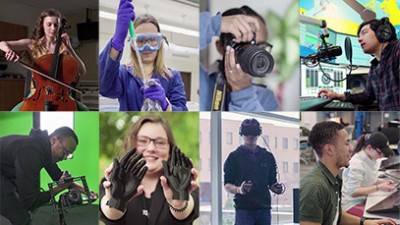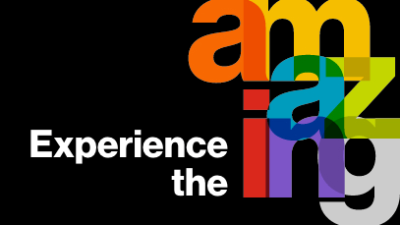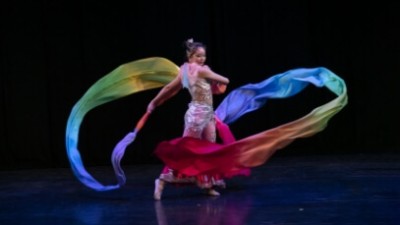American Sign Language and Deaf Cultural Studies Minor
- RIT /
- Rochester Institute of Technology /
- Academics /
- American Sign Language and Deaf Cultural Studies Minor
Overview for American Sign Language and Deaf Cultural Studies Minor
The American Sign Language and deaf cultural studies minor prepares students in the multidisciplinary study of American Sign Language and deaf culture. The minor is open to hearing and deaf students enrolled in all bachelor's degree programs. Courses in the minor address topics in the field of ASL and deaf cultural studies including the study of ASL and its structure, ASL literature, literature in English pertaining to the D/deaf experience, the history of D/deaf people in America and around the world, Deaf art and cinema, the experience of D/deaf people from racial, ethnic, and other minority groups, oppression in the lives D/deaf people, and various political, legal, and educational issues affecting members of the D/deaf community. The minor complements majors in fields such as business, imaging arts and sciences, health sciences, policy studies, professional and technical communication, psychology, and numerous scientific and technical fields.
Notes about this minor:
- Posting of the minor on the student's academic transcript requires a minimum GPA of 2.0 in the minor.
- Notations may appear in the curriculum chart below outlining pre-requisites, co-requisites, and other curriculum requirements (see footnotes).
- At least nine semester credit hours of the minor must consist of specific courses not required by the student’s degree program.
The plan code for American Sign Language and Deaf Cultural Studies Minor is ASLDCS-MN.
Curriculum for 2024-2025 for American Sign Language and Deaf Cultural Studies Minor
Current Students: See Curriculum Requirements
| Course | ||
|---|---|---|
| Required Courses | ||
| Option 1: For students who are not proficient in ASL**: | ||
| MLAS-201 | Beginning American Sign Language I |
|
ASL Includes linguistic features, cultural protocols and core vocabulary for students to function in basic ASL conversations that include ASL grammar for asking and answering questions while introducing oneself, exchanging personal information, talking about family, friends and surroundings, and discussing activities. This course is designed for students who have no knowledge of American Sign Language. Students must take placement exam if this is their first RIT class in Sign Language and they have some prior study of Sign Language. (Prerequisites: Score of 0 on RIT Language Placement Exam.) Seminar 4 (Fall, Spring, Summer). | ||
| MLAS-202 | Beginning American Sign Language II |
|
This course expands the basic principles presented in ASL I. ASL II teaches students to use linguistics features, cultural protocols and core vocabulary to function in basic ASL conversations that include ASL grammar for giving directions, describing, making request, talking about family, occupations and routines, and attributing qualities to others. (Prerequisites: Score of 1 on RIT Language Placement Exam or MLAS-201 or (C or better in NASL-180 or NASL-190) or equivalent course.) Seminar 4 (Fall, Spring, Summer). | ||
| NASL-180 | New Signers Program |
|
The New Signers Program is an intensive, fast-paced, summer pre-college experience designed for newly admitted deaf and hard-of-hearing students who have little or no prior skill in American Sign Language. Through a variety of learning experiences such as lectures, small group activities, and evening activities where students interact with other deaf and hard-of-hearing individuals, students will learn how to use ASL to communicate in real-world conversations and situations that are likely to occur on the college campus. Students will reach at a Novice-Low to Novice-Mid ASL level as recognized by the American Council on the Teaching of Foreign Languages. Interactive evening activities provide opportunities for students to be immersed in deaf culture. Students will also prepare self-reflection journals in which they document their development as signers and members of the Deaf community. (Prerequisites: This class is restricted to NTID supported students with an RIT Language Placement Exam score of 0.) Lab 4, Lecture 2 (Summer). | ||
| NASL-190 | NTID American Sign Language I |
|
This course is designed for deaf and hard-of-hearing students who have little or no prior skill in American Sign Language. Students will begin to develop receptive and expressive skills needed to converse about familiar topics using a variety of phrases, simple sentences, and questions. Students will learn vocabulary, grammar, and cultural protocols for communicating at a Novice-Low to Novice-Mid ASL level as defined by the American Council on the Teaching of Foreign Languages. (Prerequisites: This class is restricted to NTID supported students who have completed NASL-180 or equivalent course with a grade of C- or D or who have an RIT Language Placement Exam score of 0.) Lecture 4 (Fall, Spring). | ||
| NASL-200 | NTID American Sign Language II |
|
Students will develop receptive and expressive skills needed to converse about familiar topics using a series of discrete sentences. Students will learn vocabulary, grammar, and cultural protocols for communicating at a Novice-Mid to Novice-High ASL level as defined by the American Council on the Teaching of Foreign Languages. (Prerequisites: This class is restricted to NTID supported students who have completed NASL-180 or NASL-190 or equivalent course with a minimum grade of C or better or who have an RIT Language Placement Exam score of 1.) Lecture 4 (Fall, Spring). | ||
| Option 2: For students who are proficient in ASL, choose five Electives | ||
| Electives* | ||
| Option 1: Choose three or four of the following courses†: | ||
| Option 2: Choose five of the following courses†: | ||
| Language courses: | ||
| MLAS-301 | Intermediate Sign Language I |
|
This course builds upon information taught in Beginning ASL I and II and introduces expanded grammatical features of ASL and specialized vocabulary, while continuing to increase fingerspelling and numbers receptive and expressive skills. In addition, some basic features of ASL discourse are taught in organizing and explaining contextual information. (Prerequisites: Minimum score of 2 on RIT Language Placement Exam or MLAS-202 or NASL-200 or INTP-125 or equivalent course.) Seminar 3 (Fall). | ||
| MLAS-302 | Intermediate Sign Language II |
|
This course builds upon information taught in Beginning ASL I-Intermediate ASL I. Students continue learning and using ASL vocabulary, grammatical principles and various intermediate-level discourse features in narratives and presentations in ASL. Students analyze multiple meaning English words and English idioms to express concepts in ASL. Issues related to Deaf culture continue to be introduced based on unit topics. (Prerequisites: Score of 3 on RIT Language Placement Exam or MLAS-301 or NASL-210 or INTP-126 or equivalent course.) Seminar 3 (Spring). | ||
| MLAS-351 | Linguistics Of American Sign Language |
|
This course will introduce students to the study of American Sign Language (ASL) in terms of its linguistic structure and use. Students will learn to analyze the basic features of ASL phonology, morphology, syntax, semantics, pragmatics, and discourse. In addition, students will review research related to variations of ASL (e.g., Black ASL), historical linguistics, and ASL acquisition. Please note that fluency in ASL is required for this course, as instruction is in ASL (an interpreter will not be provided). (Prerequisites: MLAS-302 or MLAS-401 or MLAS-402 or INTP-225 or INTP-226 or INTP-325 or INTP-326 or equivalent course or a minimum score of 4 on the Language Placement Exam.) Seminar 3 (Fall, Spring). | ||
| MLAS-352 | American Sign Language Literature |
|
In this course, students will explore a wide range of literary works representing the various genres of ASL literature. Students will be expected to analyze works in terms of literary conventions/techniques as well as relevant cultural symbols and themes. Attention will be given to historical context, Deaf cultural values, and the style/conventions used by individual literary artists. Each student will be required to complete literary analysis papers. In addition, students will be expected to create original ASL literary works and/or retell well-known ASL literary works as individuals or in collaboration with other students. This course is requires fluency in ASL, as instruction is conducted in ASL, without an interpreter, and will require considerable reading and viewing of videotaped materials. Seminar (Fall). | ||
| MLAS-401 | Advanced American Sign Language I |
|
This course builds upon information taught in Beginning ASL I – Intermediate ASL II. Students continue learning and using ASL vocabulary, grammatical principles and various advanced-level discourse features in narratives and presentations in ASL. Students continue to analyze multiple meaning English words and English idioms to express concepts in ASL. Issues related to Deaf culture continue to be introduced based on unit topics. (Prerequisites: Score of 4 on RIT Language Placement Exam or MLAS-302 or INTP-225 or equivalent course.) Seminar 3 (Fall). | ||
| MLAS-402 | Advanced American Sign Language II |
|
This course builds upon information taught in Beginning ASL I - Advanced ASL I. Students continue learning and using ASL vocabulary, grammatical principles and various advanced-level discourse features in narratives and presentations in ASL. Students analyze different components in storytelling. ASL Literature will be introduced in this level. Students identify controversial issues in various works of ASL Literature. (Prerequisites: Score of 5 on RIT Language Placement Exam or MLAS-401 or INTP-226 or equivalent course.) Seminar 3 (Spring). | ||
| NASL-210 | NTID American Sign Language III |
|
Students will develop ASL receptive and expressive skills needed to communicate discrete paragraphs composed of connected sentences. At the end of the semester, students will achieve effective communication by using vocabulary, grammar, and cultural protocols for conveying details about familiar topics at a Novice-High to Intermediate-Low level as defined by the American Council on the Teaching of Foreign Languages. (Prerequisites: This class is restricted to NTID supported students who have completed NASL-200 or equivalent course with a minimum grade of C or better or who have an RIT Language Placement Exam score of 2.) Lecture 4 (Spring). | ||
| NASL-275 | Structure of American Sign Language |
|
This course is designed to provide students with basic knowledge about the linguistic structure of American Sign Language (ASL). Through an introduction to language features, students will examine the phonology, morphology, syntax, semantics, discourse and pragmatics of ASL. Information regarding historical and cultural aspects of ASL is also introduced and discussed. (Prerequisites: NASL-210 or MLAS-301 or MLAS-302 or MLAS-401 or MLAS-402 or equivalent course with a minimum grade of C or better or RIT Language Placement Exam score of 3 or higher.) Lecture 3 (Fall, Spring, Summer). | ||
| NASL-280 | Strategies for Teaching American Sign Language |
|
This course provides an overview of how second languages have traditionally been taught, what the current methods and theories are, and their applications to the teaching of American Sign Language. Students are provided opportunities to practice basic teaching techniques, selection of appropriate materials, design lesson plans, and use of evaluation techniques, current technology, including how to teach Deaf culture and ASL grammatical features in lessons. Students learn about resources to support their efforts to teach American Sign Language. (Prerequisites: MLAS-302 or MLAS-401 or MLAS-402 or INTP-225 or INTP-226 or INTP-325 or equivalent course or an RIT Language Placement Exam score of 4 or higher.) Lecture 3 (Fall, Spring, Summer). | ||
| Deaf cultural studies courses: | ||
| ENGL-343 | Global Deaf Literature |
|
This literature course explores the deaf elements in select literary works by deaf authors and hearing authors from different societies around the world representing various literary periods and movements. This course begins with the study of ancient writings and laws about Deaf people, documenting beliefs and values of earliest civilizations about Deaf people. Deaf culture in world literature is largely described by preconceived notions and physiognomic descriptions of Deaf people. Stories throughout world history are also characterized by varied responses to emerging educational approaches. Significant advances in medicine, science, and technology in the 19th century changed conceptions of the moral and cultural values imposed on Deaf people by hearing societies. This concept is explored through various literary lenses. The course considers global literary tradition for new interpretations of Deaf experiences. Lecture 3 (Spring, Summer). | ||
| ENGL-417 | Deaf Literature |
|
The major focus of this course is on the image of the deaf and the deaf experience as depicted in literature. The course attempts to define deafness and the cultural roles it plays in both texts by deaf authors and texts about deaf persons, as well as to examine particular literary forms related to the deaf experience. Thus, attention is also given to studying ASL poetry. (Prerequisites: Completion of First Year Writing (FYW) requirement is required prior to enrolling in this class.) Lecture 3 (Spring). | ||
| HIST-230 | American Deaf History |
|
This course explores the history of the deaf community in the United States. It offers a broad survey of American deaf history from the early 19th century to the late 20th century. Major events in American deaf history will be considered, including the foundation of schools for the deaf, the birth of American Sign Language, the emergence of deaf culture, the challenge of oralism, the threat of eugenics, and the fight for civil rights. Lecture 3 (Spring). | ||
| HIST-231 | Deaf People in Global Perspective |
|
This course explores the history of the deaf community in global perspective from the 18th to the 20th century. It takes a comparative approach, exploring the histories of deaf people from around the globe, including deaf lives in Central America, Europe, Africa, and East Asia. Special attention will be given to the major events in European deaf history, as Europe was the site for the first schools for the deaf in the history of the world, and the world's first documented deaf culture, in France, emerged there as well. The spread of deaf education, the rise of indigenous signed languages, the birth of deaf-hood, and the fight for human rights will all be placed in a global context. Lecture 3 (Fall). | ||
| HIST-330 | Deafness and Technology |
|
The deaf community has a long and complicated relationship with technological devices. The deaf community, for instance, was quick to embrace the new technology of moving pictures, and many deaf actors found work in early Hollywood during the silent film era. Most lost their livelihoods when sound was introduced to motion pictures. Deaf people were left out of the communication revolution brought about by the telephone for many years, but now the deaf community is increasingly a wired community, as texting, tweeting, and vlogging makes more communication technologies accessible to deaf users. This course will explore the historical relationship between technology and deafness. It will consider how views of deafness frequently shape technology, that is, if deafness is viewed as a pathological illness, technologies are focused on curing it (e.g., cochlear implants), whereas, if deaf people are viewed as members of linguistic and cultural minority, technologies are harnessed to make it easier for that minority to interact with the majority culture (e.g, relay systems). This course will consider how deaf people have historically used, created, and adopted technologies to their own ends. Lecture 3 (Spring). | ||
| HIST-333 | Diversity in the Deaf Community |
|
Students in this course will be introduced to the historical study of diversity in the Deaf community, especially as it relates to issues of race, ethnicity, gender, disability, and sexuality. Students will learn to analyze the implications of such diversity in terms of the social perception of deaf people, the history of the education of deaf people, and the experience of acculturation for and as Deaf people. The course will examine how the process of acculturation has operated, historically, within the Deaf community. Deaf culture has sought to transcend various differences and to bond members of the Deaf community together, in one, larger Deaf identity. But has this always been achieved? How has the Deaf community handled issues of diversity in different historical moments? Has the history of diversity within the Deaf community been similar to the history of diversity within the hearing community? Or have there been distinctively Deaf ways of diversity in history? This course will invite students to compare and contrast the history of difference and diversity in the deaf and hearing communities, and to explore those historical moments of intersection and interaction as well. Lecture 3 (Fall). | ||
| HIST-335 | Women and the Deaf Community |
|
Deaf history, as a field, has often neglected the story of deaf women. Scholar Arlene B. Kelly has recently asked, Where is deaf herstory? This course seeks to correct that gender imbalance in deaf history. We will study deaf women's history. This will include a consideration of deaf-blind women, as well, as women like Helen Keller were often the most famous deaf women of their era. But this course also seeks to look at the role of hearing women in deaf history. Hearing women dominated the field of deaf education in the late nineteenth century. They had a tremendous impact on the lives of deaf children and the events of deaf educational history. Hearing women were also important figures in deaf history as mothers. As mothers of deaf children, hearing women were frequently asked to behave as teachers in the home. Their embrace of this role often led them to endorse oral education, and oppose the sign language. Hearing mothers in this way were pitted against their adult deaf daughters, who frequently went on to learn sign language against their mothers' wishes. The historically complex relationship between women and the deaf community will be explored in this course. Lecture 3 (Biannual). | ||
| LEAD-203 | Foundation of Dialogue: Black Deaf Experiences |
|
A leader’s ability to facilitate understanding, inclusion, and resolution is key to leading a group to success. Honoring and valuing Black and Black Deaf people’s experiences are critical to creating an inclusive, empowering and effective work group. During classroom dialogue, students will actively participate in structured discussions with students and learn from each other’s perspectives, read and discuss relevant reading material, and explore avenues to resolution. Students may apply knowledge gained through dialogue and readings to lead agencies and organizations to inclusive change. Students will also explore ways of taking action to create change and bridge differences through readings, journals, leading a dialogue and a final written paper. (Prerequisite: LEAD-200 or equivalent course.) Lecture 3 (Fall, Spring). | ||
| LEAD-306 | Leadership in the Deaf Community |
|
This course will introduce historical and current issues regarding leadership and the Deaf/Hard of Hearing (D/HH) community. Students will learn about D/HH leaders in the Deaf community over the years, examine movements that have impacted the lives of D/HH individuals, and finally, learn about influential organizations of, by, and for D/HH individuals. Lecture 3 (Fall, Spring). | ||
| NASL-230 | Beginning Mexican Sign Language |
|
This course will offer beginning level Mexican Sign Language "Lengua de Senas Mexicana" (LSN). Students are required to have at least intermediate level of ASL skills. In this course, students will learn basic vocabulary, alphabet, numbers, and grammatical aspects of LSM, which they will compare with those of ASL. In addition, they will learn about Mexican culture, traditions, norms, and values along with Mexican deaf culture and compare those with the general U.S. culture and Deaf culture in the United States. (Prerequisites: This class is restricted to at least 3rd year standing in ASLINT-BS or NTID supported students and INTP-226 or MLAS-401 or equivalent course.) Lecture 3 (Spring). | ||
| NASL-240 | Beginning Russian Sign Language |
|
This course will offer a beginning level of Russian Sign Language (RSL). Students are required to have at least intermediate level of ASL skills. In this course, students will learn basic vocabulary, alphabet, numbers, and grammatical aspects of RSL, which they will compare with those of ASL. In addition, they will learn about Russian culture, traditions, norms, and values along with Russian deaf culture and compare those with the general U.S. culture and Deaf culture of the United States. Students will also learn how to write some basic words in Russian language. (Prerequisites: This class is restricted to at least 3rd year standing in ASLINT-BS or NTID supported students and INTP-226 or MLAS-301 or equivalent course.) Lecture 3 (Fall). | ||
| NHSS-251 | Deaf Culture and Contemporary Civilization |
|
This course is intended to provide students with an understanding of contemporary civilization and how it affects Deaf people’s lives. Students will learn key influences and develop an understanding of their impact on Deaf people via the topics of language, psychology, history, bioethics and human rights. Students will study a variety of social and cultural groups in order to understand the value of Deaf people in contemporary civilization. (Students in AOS or CARPRP-UND are not eligible to take this course.) Lecture 3 (Fall). | ||
| NHSS-260 | Deaf People and Civil Rights |
|
Students will learn the history and achievements of Deaf civil rights, as well as current challenges and future directions of Deaf culture and civil rights. Students will learn the basic history of disenfranchised groups in the United States, how the civil rights process is begun and its ultimate impact on the mainstream society. The course places special emphasis on research and analysis of the Americans with Disabilities Act and involvement in a civil rights project. (NTID Supported Students.) Lecture 3 (Fall, Spring). | ||
| NHSS-275 | Visual Expressions of Deaf Culture |
|
This course introduces students to Deaf Cultural Studies using stories about the Deaf experience. Students will interpret works in visual art, film, performing arts, and literature (ASL and English). Students will learn how historical/social/political and intersectional context, Deaf cultural values, and themes and symbols influence our interpretation of these creative works. Finally, the importance of collective memories for preserving Deaf cultural norms/values and promoting social justice will be addressed. Lecture 3 (Fall, Spring). | ||
| PRFN-214 | Appreciation of Artistic Sign Language |
|
This course fosters the understanding and appreciation of artistic sign language for theater, film, television, and video productions. Topics considered include the relationship between script and translation, principles of artistic sign language for stage vs. film/television, integrating Deaf and hearing performance, and accessibility advocacy. Assignments include critiques of artistic sign language in various genres from the director of artistic sign language (DASL) perspective. Due to the nature of this subject, instruction is in ASL and voice interpreters will not be provided. (Prerequisites: MLAS-301 or INTP-126 or NASL-200 or equivalent course or a minimum score of 3 on the ASL placement exam.) Lecture 3 (Fall, Spring, Summer). | ||
| PRFN-314 | ASL Musicality |
|
If music is creative and artistic expression via sounds, then what is sign language music? This course explores how music can be expressed through visual equivalents of musical elements such as harmony, melody, and timbre. It also explores musicality, the emotional and artistic qualities of music, in sign language. Other topics covered include the use of sign language poetics in visual musical performance, aesthetic considerations, and the history of music by Deaf artists, ASL music videos, and musical theatre in ASL. In addition to assigned readings, students will view and analyze a wide variety of music performance in ASL with and without sound. Due to the nature of this subject, instruction is in ASL and voice interpreters will not be provided. (Prerequisites: PRFN-214 or equivalent course.) Lecture 3 (Fall, Spring, Summer). | ||
| SOCI-240 | Deaf Culture in America |
|
This course is an introductory survey of Deaf culture in the United States. Students will study the scholarly literature pertaining to various social groups in the Deaf community and have contact with their members. This course will familiarize students with the characteristics of Deaf Culture, as well as general perceptions of the Deaf community within the dominant mainstream society. Lecture 3 (Fall, Spring). | ||
| VISL-440 | Deaf Art & Cinema |
|
Students will examine the context in which specific cultural groups have chosen to create works about their experiences. They will go on to explore a wide range of artistic works representing the Deaf experience in visual arts and cinema. Students will be expected to analyze works in terms of cultural symbols and themes. Attention will be given to historical context (personal and collective) that has helped to shape many of these works, motifs, and messages. Students will write and present in-depth papers examining specific works and artists/filmmakers. In addition, students will be expected to create an original artwork and a collaborative short film. Lecture 3 (Fall, Spring). | ||
| WGST-335 | Women and the Deaf Community |
|
Deaf history, as a field, has often neglected the story of deaf women. Scholar Arlene B. Kelly has recently asked, Where is deaf herstory? This course seeks to correct that gender imbalance in deaf history. We will study deaf women's history. This will include a consideration of deaf-blind women, as well, as women like Helen Keller were often the most famous deaf women of their era. But this course also seeks to look at the role of hearing women in deaf history. Hearing women dominated the field of deaf education in the late nineteenth century. They had a tremendous impact on the lives of deaf children and the events of deaf educational history. Hearing women were also important figures in deaf history as mothers. As mothers of deaf children, hearing women were frequently asked to behave as teachers in the home. Their embrace of this role often led them to endorse oral education, and oppose the sign language. Hearing mothers in this way were pitted against their adult deaf daughters, who frequently went on to learn sign language against their mothers' wishes. The historically complex relationship between women and the deaf community will be explored in this course. Lecture 3 (Fall). | ||
* At least one course must be at the 300 level or higher.
** 4-8 credits depending on placement. NASL courses are generally intended for deaf and hard-of-hearing students who have completed NTID NASL course work
† Students who are enrolled in the BS in ASL-English Interpretation must complete the minor by taking Deaf Cultural Studies courses only. All courses must be different than the one Deaf Cultural Studies courses required for the BS degree. All students must complete at least five courses for the minor.
Contact
- Leisa Boling
- Assistant Professor
- Department of ASL and Interpreting Education
- National Technical Institute for the Deaf
- lrbnss@rit.edu
- Jillian Sinclair
- Senior Staff Assistant
- Department of Liberal Studies
- National Technical Institute for the Deaf
- jlsnts@rit.edu
Department of Modern Languages and Cultures










